Speech The Labour Market and Spare Capacity
I would like to thank CEDA for the invitation to address this lunch. It is a great pleasure to be back in Adelaide and to participate in another CEDA event.
Those of you who follow the RBA closely would have noticed frequent references to the labour market in our recent communication. Today, I would like to explain why this is so and also discuss how we assess the amount of spare capacity in the labour market. I will then finish with some comments on monetary policy.
The Broad Policy Framework
Students of central bank history would be aware that the Reserve Bank Act was passed by the Australian Parliament in 1959 – 60 years ago. In terms of monetary policy, the Parliament set three broad objectives for the Reserve Bank Board. It required the Board to set monetary policy so as to best contribute to:
- The stability of the currency
- The maintenance of full employment
- The economic prosperity and welfare of the people of Australia
These objectives have remained unchanged since 1959. Here, in Australia, we did not follow the fashion in some other parts of the world over recent decades of setting just a single goal for the central bank – that is, inflation control. In my view it was very sensible not to follow this fashion. Our legislated objectives – having three elements – are broader than those of many other central banks. The third of our three objectives serves as a constant reminder that the ultimate objective of our policies is the collective welfare of the Australian people.
From an operational perspective, though, the flexible inflation target is the centre piece of our monetary policy framework. The target – which has been agreed to with successive governments – is to deliver an average rate of inflation over time of 2–3 per cent. Our focus is on the average and on the medium term.
Inflation averaging 2 point something constitutes a reasonable definition of price stability. Achieving this stability helps us with our other objectives. Low and stable inflation is a precondition to the attainment of full employment and it promotes our collective welfare. As I have said on other occasions, we are not targeting inflation because we are inflation nutters. Rather, we are doing so because delivering low and stable inflation is the most effective way for Australia's central bank to promote our collective welfare.
So where does the labour market fit into all this?
The answer is that it is central to all three objectives.
The connection with the second objective – full employment – is obvious. The RBA is seeking to achieve the lowest rate of unemployment that can be sustained without inflation becoming an issue. In doing this, one of the questions we face is what constitutes full employment in a modern economy where work arrangements are much more flexible than they were in the past. I will return to this issue in a moment.
The labour market is, of course, also central to the third objective in our mandate – our collective welfare. It is stating the obvious to say that for many Australians, having a good job at a decent rate of pay is central to their economic prosperity.
Trends in the labour market also have a major bearing on inflation outcomes, so they are important for the first element of our mandate as well. Over time, there is a close link between wages growth and inflation. And a critical influence on wage outcomes is the balance between supply and demand in the labour market; or in other words how much spare capacity is there in the labour market? This question is closely linked to the one about what constitutes full employment.
So, it is natural that we focus on the labour market as the Board makes its monthly decisions about interest rates.
Spare Capacity
With that background I would now like to discuss how we assess the degree of spare capacity in the Australian labour market. I will do this from four perspectives:
- The rates of unemployment and underemployment
- The flexibility of labour supply
- The effectiveness with which people are matched with job vacancies
- Trends in wages growth.
Unemployment and underemployment
The conventional measure of spare capacity in the labour market is the gap between the actual unemployment rate and the unemployment rate associated with full employment. Even at full employment, some level of unemployment is to be expected as workers leave jobs and search for new ones. As my colleague Luci Ellis discussed last week, we don't directly observe the unemployment rate associated with full employment – we need to estimate it.[1] Over recent times there has been a gradual accumulation of evidence which has led to lower estimates. While it is not possible to pin the number down exactly, the evidence is consistent with an estimate below 5 per cent, perhaps around 4½ per cent. Given that the current unemployment rate is 5.2 per cent, this suggests that there is still spare capacity in our labour market.
The fact that the conventional estimate of spare capacity is based on the unemployment rate reflects an implicit assumption that if you have a job you are pretty much fully employed. In decades past, this might have been a reasonable assumption. But it is not a realistic assumption in today's modern flexible labour market.
As more people work part time, it has become increasingly common to be both employed and to work fewer hours than you want to work. In the 1960s, less than one in ten workers worked part time (Graph 1). Today, one in three of us works part time. Almost one in two women work part time and more than one in two younger workers work part time.
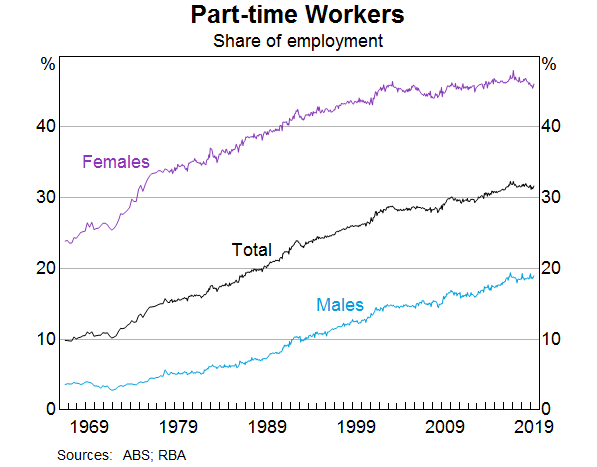
A few more facts are perhaps helpful here. According to the ABS, around 3 million people work part time because they want to, not because they can't find a full-time job. Most people who are working part time do so because they are studying or have caring responsibilities, or for other personal reasons. So we should not think of part-time jobs as being bad jobs, and full-time jobs as being good jobs. Rather, one of the success stories of the Australian labour market is that we have been able to accommodate this desire for part-time work and flexibility.
Having said that, around one-quarter of people working part time are not satisfied with the hours they are offered and would like to work more hours: we can think of these people as underemployed (Graph 2). The share of part-time workers who are underemployed moves up and down from year to year, and the current share is above its average level over the past two decades.
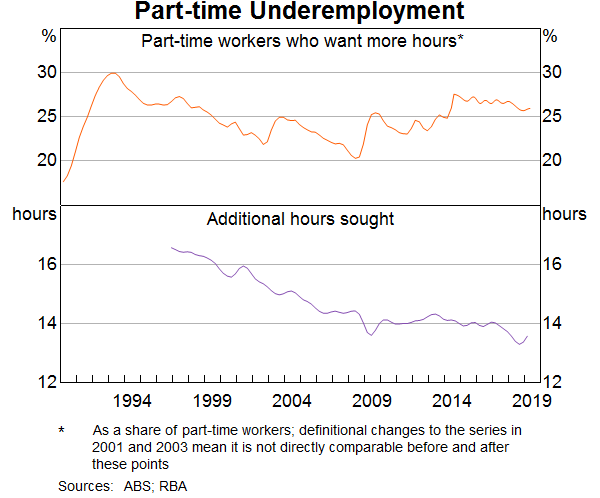
As part of the ABS's monthly survey of 50,000 people, it asks underemployed workers how many extra hours they would like to work. On average, they answer that they would like to work an extra 14 hours per week. It is interesting that this figure has trended down over the past two decades; it used to be more than 16 hours. Over the same period, the average hours worked by part-time workers has increased by around 2 hours to 17 hours per week. Taken together, these data suggest that businesses are doing a better job of providing the hours that part-time workers are seeking.
This shift to part-time work means that in assessing spare capacity we need to consider measures of underemployment as well as measures of unemployment. The RBA has been doing this for some time. As part of our efforts here, we have constructed a measure of underutilisation that takes account of the part-time workers who want to work more hours. This measure adds the extra hours sought by these workers to the hours sought by those who are unemployed (Graph 3).[2] These extra hours are equivalent to around 3.3 per cent of the labour force, which, taking account of conventional unemployment, means that the underutilisation rate is 8.1 per cent. This hours-based measure is preferable to heads-based measures of underutilisation that treats an unemployed person in the same way as a part-time worker seeking a few more hours.
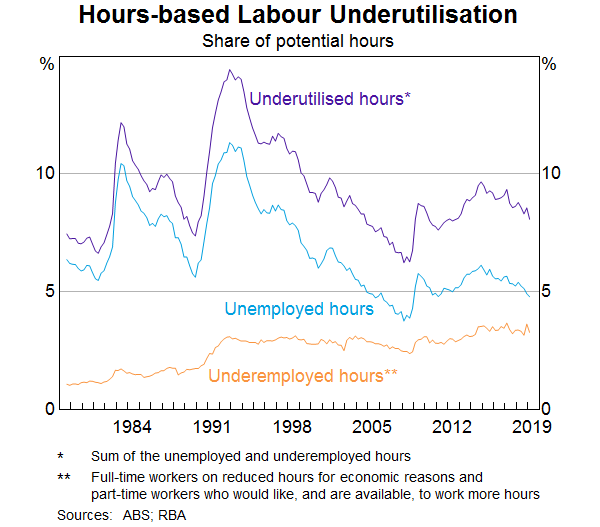
Unlike the unemployment rate, which has trended down over the past 20 years, the underemployment rate has been relatively stable. These different patterns in unemployment and underemployment suggest that fewer inroads have been made into spare capacity in the labour market than suggested by looking at the unemployment rate alone. This is something we take into account in thinking about monetary policy.
There is, though, one other perspective on the measure of underemployment that I would like to share with you. In the past, when part-time work was not as readily available, many people – mostly women – faced the choice of taking full-time paid employment or no paid employment at all. Many chose to, or had to stay outside the labour force because working was not a realistic option. From the perspective of society as a whole, this was a serious form of underutilisation – it just wasn't measured as such by the ABS.
Given the trend towards part-time and more flexible jobs, people have more options than they had before and many have chosen to join, or have deferred leaving, the labour force.[3] From the perspective of adding to the productive capacity of the nation, this is a good outcome and if there was a measure of underutilisation that took account of exclusion from the workforce, it would surely have declined. I don't want to downplay the issue of underemployment, but it is worth recognising this broader perspective, and remembering where we have come from.
Flexibility of the supply side
This naturally brings me to my second window into spare capacity in the labour market – the flexibility of labour supply.
Over the past 2½ years, the working-age population has increased at an annual rate of around 1¾ per cent. Over that same time period, employment has increased at an average rate of 2¾ per cent. The fact that employment has been increasing considerably faster than the working-age population has led to a reduction in the unemployment rate, but the reduction is not as large as might have been expected. The reason for this is that the supply of labour has increased in response to the stronger demand for workers.
This flexibility in labour supply is evident in the substantial rise in labour force participation. The participation rate currently stands at 66 per cent, which is the highest on record (Graph 4). Reflecting this, the share of the working-age population in Australia with a job is currently around the record high it reached at the peak of the resources boom. As I discussed a few moments ago, the availability of part-time and flexible working arrangements is one reason for this.
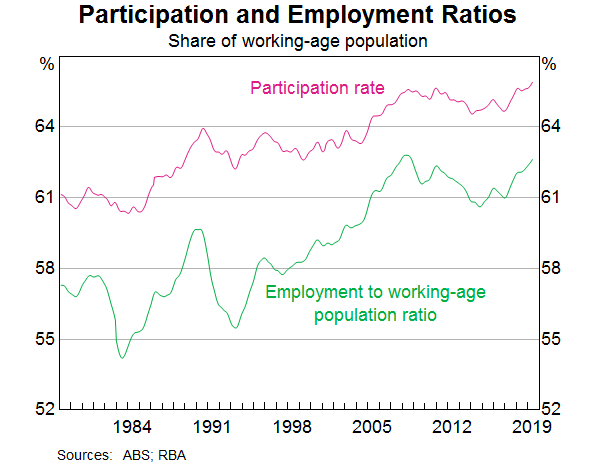
There are two groups for which the rise in participation has been particularly pronounced: women and older Australians (Graph 5). The female participation rate now stands at 61 per cent, up from 43 per cent in 1979. Australia's female participation rate is now above the OECD average, although it remains below that of a number of countries, including Canada and the Netherlands.
The participation rate of older workers has also increased over recent decades as health outcomes have improved and changes have been made to retirement policies. The eligibility age for the pension was progressively raised from 60 to 65 for females and is now being gradually increased to 67 for everybody by 2023. The preservation age at which individuals can access their superannuation is also being gradually increased. These changes are contributing to higher participation by older Australians.
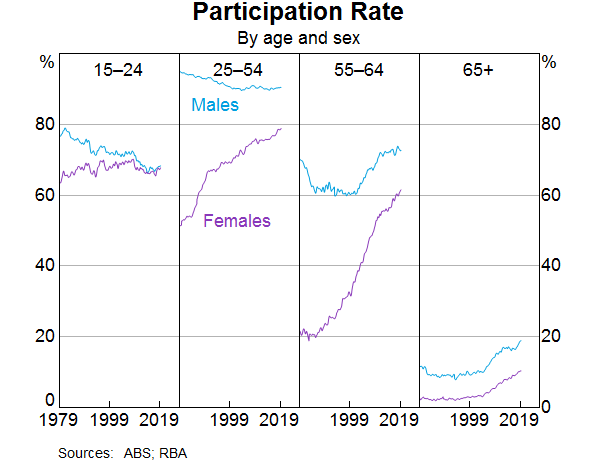
Another source of potential labour supply is net overseas migration. Migration, including temporary skilled workers, increased sharply during the resources boom when demand for skilled labour was very strong, and has subsequently declined (Graph 6). While migrants add to both demand and supply in the economy, they can be a particularly important source of capacity for resolving pinch-points where skill shortages exist.
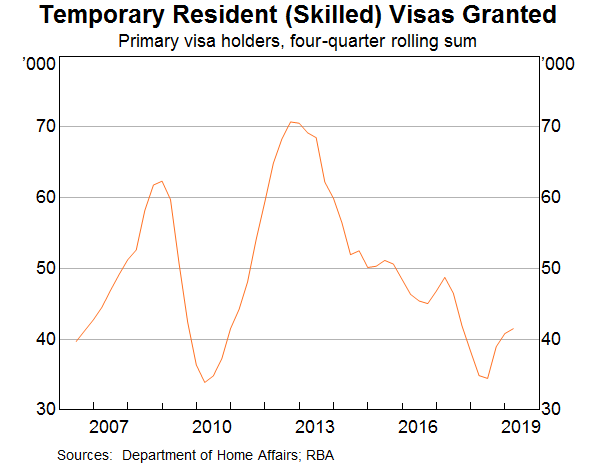
A related source of flexibility stems from our unique relationship with New Zealand. When labour demand is relatively strong in Australia, there tends to be an increase in the net inflow of workers from New Zealand to Australia. When conditions are relatively subdued here, the reverse occurs. During the resources boom, the inflow from across the Tasman was as large as the inflow of temporary skilled workers.
The overall picture here is one of a flexible supply side of the labour market. When the demand for labour is strong, more people enter the jobs market or delay leaving. This rise in participation is a positive development. But it is one of the factors that has meant that strong demand for labour has not put much upward pressure on wages.
The matching of people with jobs
A third perspective on spare capacity in the labour market can be gained from examining how well people looking for jobs are matched with the jobs that are available. Looking at the labour market from this perspective, things look a little tighter than suggested by the other two perspectives that I have discussed.
Currently, almost 60 per cent of firms report that the availability of labour is either a minor or a major constraint on their business (Graph 7). This share is not as high as it was during the resources boom, but it is still quite high. Reports from the RBA's liaison program suggest that there are currently shortages of certain types of engineers, workers with specialised IT skills and some tradespeople associated with public infrastructure work. Businesses in regional areas are also more likely to report a greater degree of difficulty finding suitable labour.
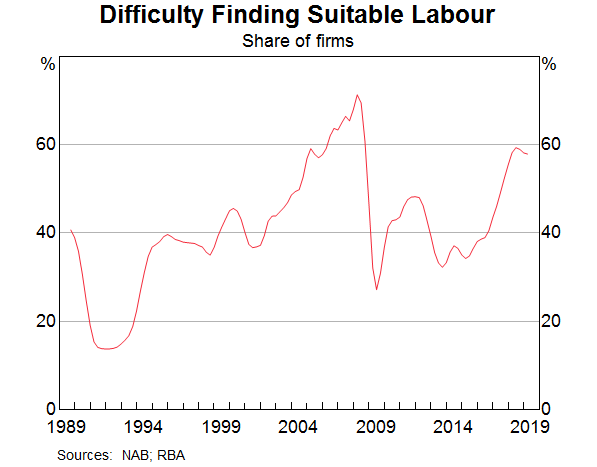
One contributing factor here is an underinvestment in staff training. In the shadow of the global financial crisis many firms cut back training to reduce costs. We are now seeing some evidence of the adverse longer-term implications of this. As the labour market tightens further, I would hope that more firms are prepared to hire workers and provide the necessary training.
Another lens on job matching is the ratio of the number of unemployed people to the number of job vacancies (Graph 8). At present, there are fewer than three unemployed people for each vacancy. This compares with over 20 people for every vacancy in the early 1990s recession and five people for every vacancy in 2014. From this perspective the labour market looks reasonably tight. There is also some tentative evidence that, on average, unemployed workers are not as well matched to job vacancies as was the case in 2007, when the ratio of the two was at a similar level.
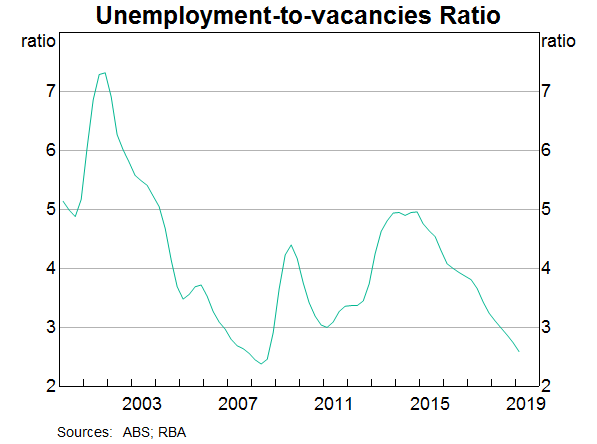
One such piece of evidence is that as the unemployment rate has come down over recent years, there has been little progress on reducing very long-term unemployment, defined as those who are unemployed for more than two years (Graph 9). Addressing the causes of this chronic unemployment remains an important challenge for our community. More positively, the share of the labour force that has been unemployed between one and two years has trended down over recent times.
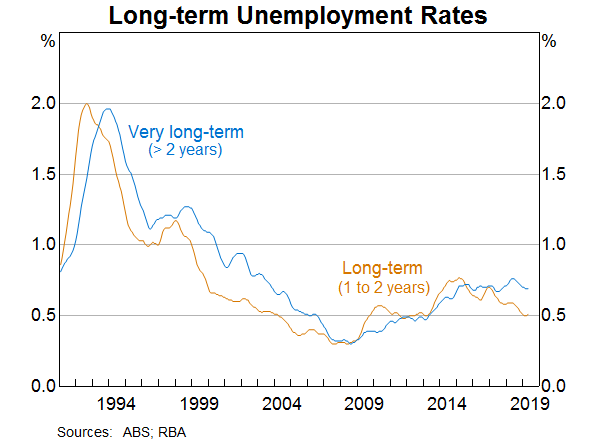
Another lens on job matching and the overall tightness of the labour market is the rate of job mobility; that is, how often people change their jobs. Here, the evidence is interesting. Despite the frequent reports of a lack of job security and regular job switching by millennials, the average time that workers are staying with an employer is increasing. Reflecting this, the share of employed people who switch employers in a given year is the lowest it has been in a long time (Graph 10). Looking at the data by occupation, the rate of job mobility is lowest for managers and business professionals and highest for tradespeople and workers in the hospitality industry.
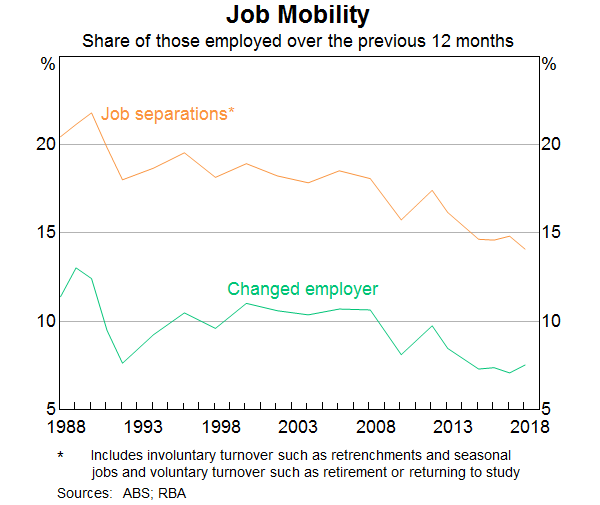
In a tight labour market, we would expect to see either strong wages growth or frequent job changing as businesses seek out workers. But we are seeing neither at present. One possible explanation for this is the uncertainty that many people feel about the future. This uncertainty means that if you have a job you want to keep it rather than take a risk with a new employer. This might be especially so if you also have a large mortgage. So it is possible that the high level of household debt is also affecting labour market dynamics.
Wages
I will now turn to the fourth perspective on labour market tightness – that is wages growth.
Over the past year, wages growth has picked up as the labour market tightened. This is not surprising given the strength of demand for labour. But the pick-up has been fairly modest and is only evident in the private sector (Graph 11). Over the past year, the private-sector Wage Price Index increased by 2.4 per cent, up from 1.9 per cent in the previous year. The past two quarters have, however, seen lower wage increases than in the previous two quarters.
In contrast to trends in the private sector, wages growth in the public sector has been steady at around 2½ per cent, largely reflecting the wage caps across much of the public sector.
It is also worth pointing out that overall wages growth in New South Wales and Victoria has been running at just 2½ per cent despite the unemployment rate being 4½ per cent or lower over the past year.
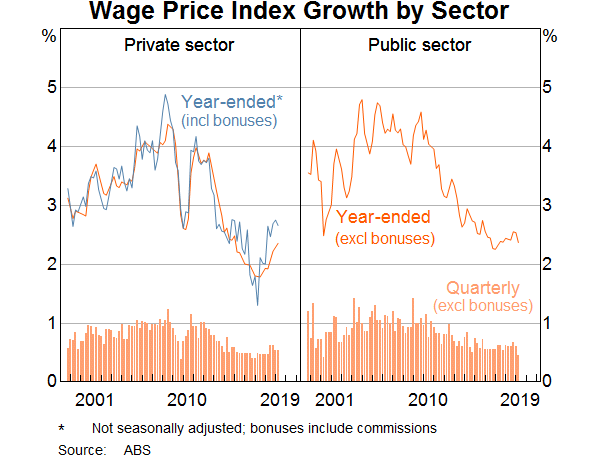
Another perspective on wages growth is from the national accounts, which reports average earnings per hour worked (Graph 12). This measure is volatile, but the latest data painted a fairly weak picture, with average hourly earnings up by just 1 per cent over the past year.
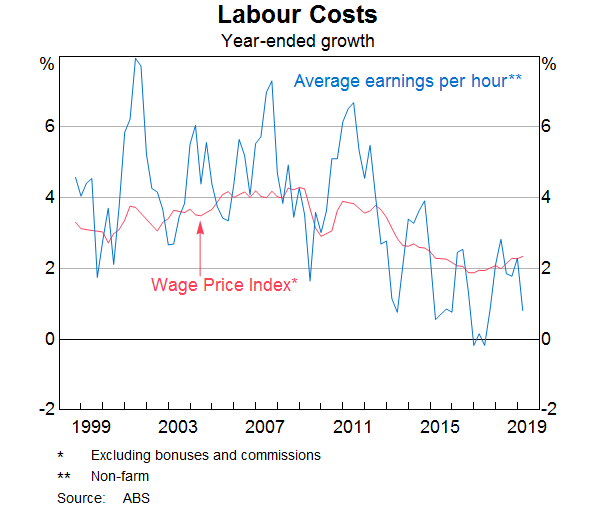
In summary, the overall picture from these various windows into the labour market is that despite the strong employment growth over recent times, there is still considerable spare capacity in the labour market. We remain short of the unemployment rate associated with full employment, there is significant underemployment and there is further potential for labour force participation to increase when the jobs are there. Consistent with all of this, wages growth remains modest and is below the rate that would ensure that inflation is comfortably within the 2 to 3 per cent range. The one caveat to this assessment is the difficulty that some firms are having finding workers with the necessary skills. This underlines the importance of workplace training.
Monetary Policy
I would like to finish with a few words on monetary policy.
As you are aware, the Reserve Bank Board reduced the cash rate to 1¼ per cent at its meeting earlier this month. This was the first adjustment in nearly three years.
This decision was not in response to a deterioration in the economic outlook since the previous update was published in early May. Rather, it reflected a judgement that we could do better than the path we looked to be on.
The analysis that I have shared with you today supports the conclusion that the Australian economy can sustain a higher rate of employment growth and a lower unemployment rate than previously thought likely. Most indicators suggest that there is still a fair degree of spare capacity in the economy. It is both possible and desirable to reduce that spare capacity. Doing so will see more people in jobs, reduce underemployment and boost household incomes. It will also provide greater confidence that inflation will increase to be comfortably within the medium-term target range.
Monetary policy is one way of helping get us onto to a better path. The decision earlier this month will assist here. It will support the economy through its effect on the exchange rate, lowering the cost of finance and boosting disposable incomes. In turn, this will support employment growth and inflation consistent with the target.
It would, however, be unrealistic to expect that lowering interest rates by ¼ of a percentage point will materially shift the path we look to be on. The most recent data – including the GDP and labour market data – do not suggest we are making any inroads into the economy's spare capacity. Given this, the possibility of lower interest rates remains on the table. It is not unrealistic to expect a further reduction in the cash rate as the Board seeks to wind back spare capacity in the economy and deliver inflation outcomes in line with the medium-term target.
It is important though to recognise that monetary policy is not the only option, and there are limitations to what can be achieved. As a country we should also be looking at other ways to get closer to full employment. One option is fiscal policy, including through spending on infrastructure. Another is structural policies that support firms expanding, investing, innovating and employing people. Both of these options need to be kept in mind as the various arms of public policy seek to maximise the economic prosperity of the people of Australia.
Thank you for listening. I would be happy to answer your questions.
Endnotes
I would like to thank Natasha Cassidy, Blair Chapman and Ewan Rankin for assistance in the preparation of this talk. [*]
Ellis L (2019), ‘Watching the Invisibles’, The 2019 Freebairn Lecture in Public Policy, University of Melbourne, 12 June. [1]
The ABS also produces a similar ‘volume’ measure of underutilisation with a much shorter history. [2]
For more on trends in workplace flexibility and the rise in part-time work see Heath A (2018), ‘The Evolving Australian Labour Market’, Speech at the Business Educators Australasia 2018 Biennial Conference, Canberra, 5 October. [3]
